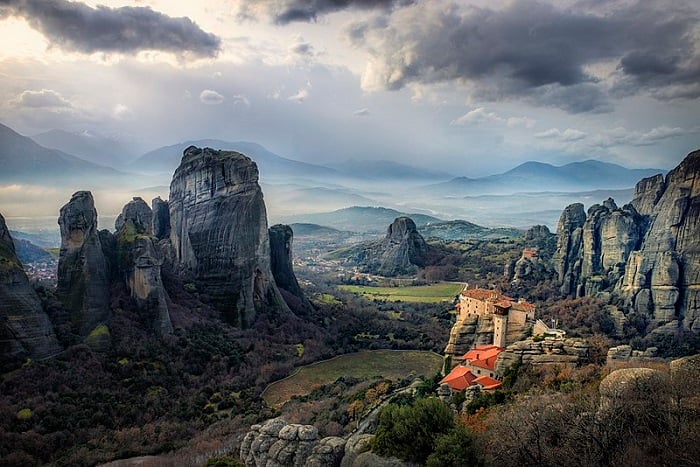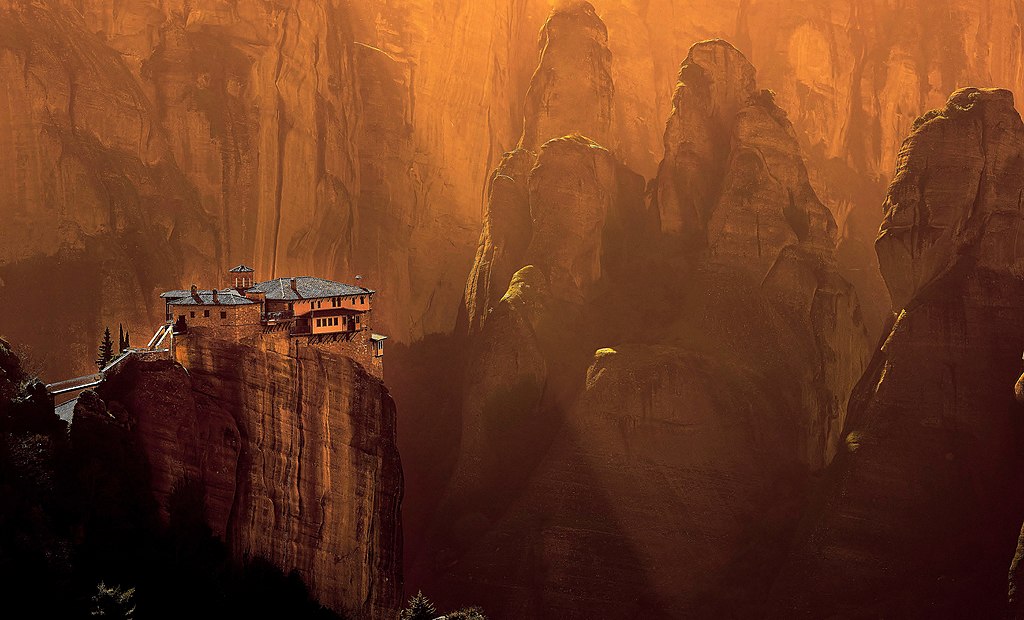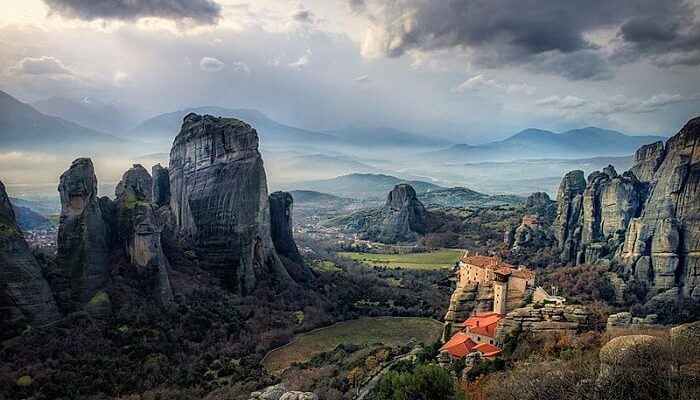
Meteora, Greece, is like no other place on Earth; indeed, in many ways, it looks as if it is on another planet, with its stalagmite-like rocks that reach into the sky amid a backdrop of craggy mountains dotted with red-roofed monasteries.
The unique geological formations that make this place unforgettable and which almost defy description are just some of the characteristics that attract people to Meteora.
Located near the town of Kalabaka at the northwestern edge of the Plain of Thessaly near the Pineios River and Pindus Mountains, Meteora is included on the UNESCO World Heritage List.
Mountain climbers who want to test their mettle against the sheer vertical walls of the rocks make the pilgrimage to Meteora alongside religious pilgrims who are amazed by the treasures of the monasteries that are perched on the cliffs.
The immense monoliths, which have been split by earthquakes and eroded by water and wind over millions of years, are an authentic masterpiece of nature.
Emerging about twenty-five million years ago as part of the elevated seabed which was thrust into the sky as the result of massive tectonic movements, the Meteora rocks have created a landscape that looks like something out of a fairy-tale albeit perhaps a scary one.
Now home to one of the largest and certainly the most precipitously built complexes of Eastern Orthodox monasteries, Meteora is second in importance only to Mount Athos in religious centers of Orthodox monasticism.
The six (of an original twenty-four) monasteries are built on the immense natural pillars and towering rock outcrops that dominate the local area. The rock formations have been a site of worship for the people of the area as far back as the Turkish advances that were made in the area.
Between the 13th and 14th century, twenty-four monasteries were constructed atop the rocks as a way to keep the monks safe from the encroaching armies of the Turks.
The word Meteora itself, meaning “lofty,” or “elevated,” is etymologically related to the word meteor, leading to an even more otherworldly feeling when one sees the name.
Next to the Pindos Mountain range, in the western Greek region of Thessaly, the enormous columns of rock rise almost majestically from the ground. But these unique rock formations are not easy to explain geologically. They are not volcanic plugs of hard igneous rock, as can be seen elsewhere; the rocks are composed of a mixture of sandstone and conglomerate.
The conglomerate was formed of deposits of stone, sand, and mud from streams flowing into a delta at the edge of a lake over millions of years, geologists believe. About sixty million years ago during the Paleogene period, a series of earth movements pushed the seabed upward, creating a high plateau and causing many vertical fault lines in the thick layer of sandstone.
The huge rock pillars were then formed by the weathering effects of water, wind, and extremes of temperature on the vertical faults. Geologists consider it unusual that this conglomerate formation and type of weathering are confined to a relatively localized area within the surrounding mountain formation.
What makes Meteora’s appearance special is the uniformity of the sedimentary rock constituents that were deposited over millions of years, leaving few signs of vertical layering and the localized abrupt vertical weathering, creating its staggeringly beautiful pillars.

Excavations and research have discovered petrified diatoms at Meteora, which have contributed to understanding the Palaeo-climate and climate changes. Radiocarbon dating shows evidence of human presence there dating back fifty thousand years.
Vegetation sprouts out of many of the vertical rock walls due to the water that runs down the cracks and crevices in the cliff. Over the past several hundred years, there were reports that Meteora was easily accessible by foot; now, this is not the case because one must pass through an impenetrable jungle to get to the top of some of the pillars.
As massive unpredictable rock pillars, rock falls pose a constant threat to pilgrims and tourists at Meteora, Greece. An earthquake of 7.0 on the Richter Scale shook Meteora in 1954, and certainly many others have occurred there throughout the eons, but miraculously, the pillars still stand today.
Back in 2005, such a massive rock fell that it closed the access road leading up to the area for several days.
Cave of Theopetra home to Neanderthals
The nearby cave of Theopetra is located four kilometers (2.5 miles) from Kalambaka, one of the towns nearest Meteora. Its uniqueness from an archeological perspective is that this single site contains evidence from two hugely significant cultural transitions: the replacement of Neanderthals by modern humans, and later, the transition from hunting-gathering to farming after the end of the last Ice Age.
The cave was once open to the public, but it is currently closed indefinitely, for safety reasons.
The cave consists of an immense five hundred square meter (5,400 square foot) rectangular chamber at the foot of a limestone hill, which rises to the northeast above the village of Theopetra, with an entrance seventeen meters (56 feet) wide by three meters (9.8 feet) high.
It lies at the foot of the Chasia mountain range, which forms the natural boundary between Thessaly and Macedonia while the Lithaios River, a tributary of the Pineios River, flows in front of the cave. The small river, flowing literally on the doorsteps of the cave, meant that cave dwellers always had easy access to fresh, clean water without the need to cover long distances daily to find it.
Archeologists have found that caves in the vicinity of Meteora were inhabited continuously between fifty thousand and five thousand years ago. The oldest known example of a purposely-built structure, a stone wall that blocked two-thirds of the entrance to the Theopetra cave, was constructed twenty-three thousand years ago, most likely as a barrier against cold winds since the Earth was experiencing an ice age at the time.
A great number of important Paleolithic and Neolithic-era manmade artifacts have been found within the caves.
Incredibly, although the greater surrounding area was clearly inhabited for tens of thousands of years, Meteora is not mentioned in classical Greek myths or ancient Greek literature.
The first great ascetics come to Meteora, Greece
The first people documented to inhabit Meteora after the Neolithic Era were an ascetic group of Christian monks who wanted to lead lives of great ascetism. They began living on the ancient rock pinnacles in the ninth century AD, after the fashion of the Stylites, the early Christian ascetics who lived atop pillars as a way to better commune with God.
They lived in natural hollows and fissures in the rock towers, some as high as 1,800 feet (550 meters) above the plain. This great height, combined with the sheerness of the cliff walls, kept away all but the most determined visitors. Initially, the hermits led a life of solitude, meeting only on Sundays and special days to worship and pray in a chapel built at the foot of a rock known as Dhoupiani.
However, actual monasteries were not built until the fourteenth century, when the monks needed a more secure place to hide in the face of an increasing number of Turkish attacks on Greece.
Monastic state of the Skete of Stagoi established
By the late eleventh and early twelfth centuries, a rudimentary monastic state had formed called the Skete of Stagoi, which was centered around the still-extant church of Theotokos (Mother of God).
In 1344, Athanasios Koinovitis from the monastic center Mount Athos brought a group of followers to Meteora. From 1356 to 1372, he and his men built The Great Meteoron Monastery on the Broad Rock, which was perfect for the monks; they were safe from marauders of every kind and had complete control of the entry to the monastery.
The only means of reaching it was by climbing a long ladder, which was drawn up whenever the monks felt threatened.
At the end of the fourteenth century, the Byzantine Empire’s reign over northern Greece was being increasingly threatened by Turkish raiders who wanted control over the fertile plain of Thessaly.
In 1517, Theophanes built the monastery of Varlaam, which was reputed to house relics such as the finger of St. John and the shoulder blade of St. Andrew.
Access to the monasteries was originally (and deliberately) difficult, requiring either long ladders that were pieced together or large nets that were used to haul up both goods and people.
This required quite a leap of faith, however, because the ropes were replaced, so the story goes, only “when the Lord let them break.”
UNESCO: “Traditional way of life threatened with extinction”
UNESCO notes in its overview of the World Heritage site of Meteora that “the net in which intrepid pilgrims were hoisted up vertically alongside the 373 meters (1,224 feet) cliff where the Varlaam monastery dominates the valley symbolizes the fragility of a traditional way of life that is threatened with extinction.”
Until the seventeenth century, the primary means of conveying goods and people from these eyries was by means of these very baskets and ropes.
Of course, getting up to the summits is a great deal simpler these days after steps were carved into the rock starting in the 1920s. But climbing these, as anyone can imagine, is not for the faint of heart.
Of the original twenty-four religious buildings at Meteora, only four monasteries and two convents are still functioning, with each housing fewer than ten individuals.
In 1921, Queen Marie of Romania visited Meteora, becoming the first woman ever allowed to enter the Great Meteoron monastery.
The Monasteries of Greece’s Meteora
At their peak of development in the sixteenth century there were twenty-four monasteries at Meteora, with much of their architecture, of course, Athonite in origin. The six religious structures today are accompanied by the ruins of the others which have fallen into disrepair.
The Great Meteoron is oldest of all Meteora monasteries
The Holy Monastery of Great Meteoron is the oldest and largest of the monasteries of Meteora. The monastery is believed to have been built just before the mid-14th century by a monk from Mount Athos named Saint Athanasios Meteorites.
Dedicated to the Virgin Mary, the Mother of God, his monastery later added small cells so that monks could live there in peace and seclusion atop the rock. Also known as The Holy Monastery of the Transfiguration, it takes its name from the second church St. Meteorites built.
The successor of Saint Meteorites was a monk named Saint Joasaph who continued to build more cells, as well as a hospital for them, renovating the churches there as well. The Monastery thrived in the 16th century when it received many imperial and royal donations.
At that time, it had over three hundred monks living and worshiping within its cells. It is still a functioning monastery since there are three monks in residence there.
The largest of all Meteora monasteries, there are many buildings belonging to the complex there. The katholikon, dedicated to the Transfiguration of Jesus, was the first church for the monastery.
The hermitage of the first founder of the monastery is a small building carved into the rock itself. The kitchen, commonly referred to as the hestia, is a domed building near the refectory. There is also a hospital, with its famous roof made of brick and supported by four columns.
The three other old churches or chapels include: The Chapel of Saint John the Baptist, which lies next to the katholikon sanctuary; The Saints Constantine and Helen Chapel which is an aisle-less church with a large vault; and the chapel of Virgin Mary, which is in the cave.
The Monastery of Varlaam
The Monastery of Varlaam, the second largest monastery at Meteora, takes its name from a monk of the same name, who first scaled the rock on which it is perched in 1350.
Varlaam built three churches by laboriously hoisting materials up the face of the cliffs. After his death, however, the monastery was abandoned for two hundred years until two brothers who were monks, Theophanes and Nektarios Apsarades, came to the rock in the 16th century and began to rebuild the churches in October of 1517.
The two brothers from Ioannina spent twenty-two years hoisting materials to the top of the rock formation. However, the construction itself was reported to have taken only approximately twenty days.
Monks have been present there since the 16th century, but there has been a constant decline in their presence since the 17th century. Today, the monastery can be accessed through a series of ladders that scale the northern side of the rock. The museum there is open to these brave visitors; it contains a wide array of relics and ecclesiastical treasures for those who are courageous enough to make the journey.
As of 2015, there were seven monks remaining in Varlaam.
The Monastery of Rousanou
Rousanou, which is also perched on a lofty pillar, is believed to have been constructed, like many of the other monasteries, in the 14th century. The cathedral is believed to have been built in the 16th century and decorated in 1540. The name Rousanou is believed to come from the first group of monks who settled on the rock and were from Russia.
The monastery is located at an elevation of 484 meters (1,587 feet). From its position in the middle of Meteora, visitors can look out and see the other monasteries as well as the ruins of the Monastery of St. John the Baptist and the Pantokrator.
The Monastery of St. Nicholas Anapausas
The Monastery of St. Nicholas Anapausas is located atop a slender rock pillar measuring approximately eighty meters high. It is the first pillar pilgrims encounter when making their way to the holy Meteora. The Monastery, which was founded in the late 14th century, today is surrounded by the ruined monasteries of St. John Prodromos, the Pantocrator, and the chapel of Panagia Doupiani, which are all empty now.
The monastery once served as a resting place for pilgrims and quickly got its name of “Anapausas” referring to word anapafseos, or “resting.” Situated on the incredibly narrow top of a pillar, the floors are connected through an interior staircase. St. Nicholas is honored on the second floor, where the katholikon is located. On the third floor, there is the Holy Altar and the walls are decorated by 14th-century frescoes. The monastery was restored in the 16th century and again in the 1960s.
The Monastery of The Holy Trinity
The Monastery of the Holy Trinity is believed to have been built in the 14th and 15th century. Even prior to this, ascetics had established hermitages at the base of the rock on which it stands.
In the 14th century, John Uroš moved to the Meteora and endowed and built monasteries on top of this cliff as sanctuaries and safe havens during times of political upheaval. In 1438, Dometius was said to be the first monk to live at Holy Trinity.
The actual monastery is believed to have been constructed between 1475 and 1476.
The Monastery of St. Stephen
The Monastery of St. Stephen is located on a plateau atop another spectacular rock pillar of Meteora. The original monastery was believed to have been built in the 14th century. However, a new katholikon was built in 1798, making it the newest of all the structures at Meteora.
The monastery is made up of many buildings including the new katholikon, the “hestia” (kitchen), an old refectory that has since become a museum, and an assortment of workrooms devoted to different purposes, including painting, embroidery, and incense-making.
The church’s interior was decorated with frescoes after 1545. However, during the world wars, the monasteries were tragically heavily bombed and then ransacked in the belief that the monks were holding refugees there. As of 2015, the Monastery of St. Stephen is home to twenty-eight nuns after its conversion to a convent in 1961.



